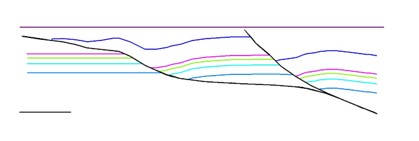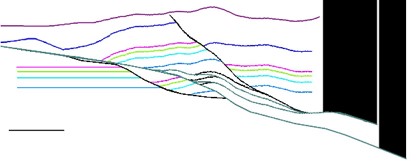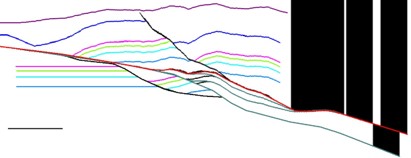Carboniferous structure model
Variscan overprint on extensional structure in the Carboniferous
Low-angle inversion footwall-collapse faults are common in Carboniferous basin fault blocks, can be quite well imaged on 2D recce seismic, and have been ignored by generations of interpreters. Variscan inversion structures are readily seen in the Lower Carboniferous when you expect them and look for them. Here we show footwall-collapse modelling creating analogous structures, using our own software DepthCon.
There is no representation of fault systems like this in the picked seismic on UKOGL, and it offers new guidelines in exploring Lower Carboniferous structure potential.
1
Early Carboniferous “roll-off” extension on arcuate growth faults established rollovers, local half-graben and sag depocentres.
2
In shortening, high-angle extensional faults tend not to reverse (if they do, its strike-slip), whilst the lower-angle flats can do so, interlinking with new low-angle break-back fractures developing in hangingwalls and footwalls. That process is starting here, green fault.
3
Multiple new break-back surfaces can develop, sometimes with duplexing as pore-pressures leak off existing fractures.
4
Fold amplitude can develop as new fractures successively form and decline, their shapes determine the geometry of shortening structures.
5
The red surface here has acquired additional heave, repetition of simple process generates complex geometries. Interpreters are challenged to recognise which reflectors are beds and which are fault surfaces.
UKOGL reports almost never portray low-angle faults.







